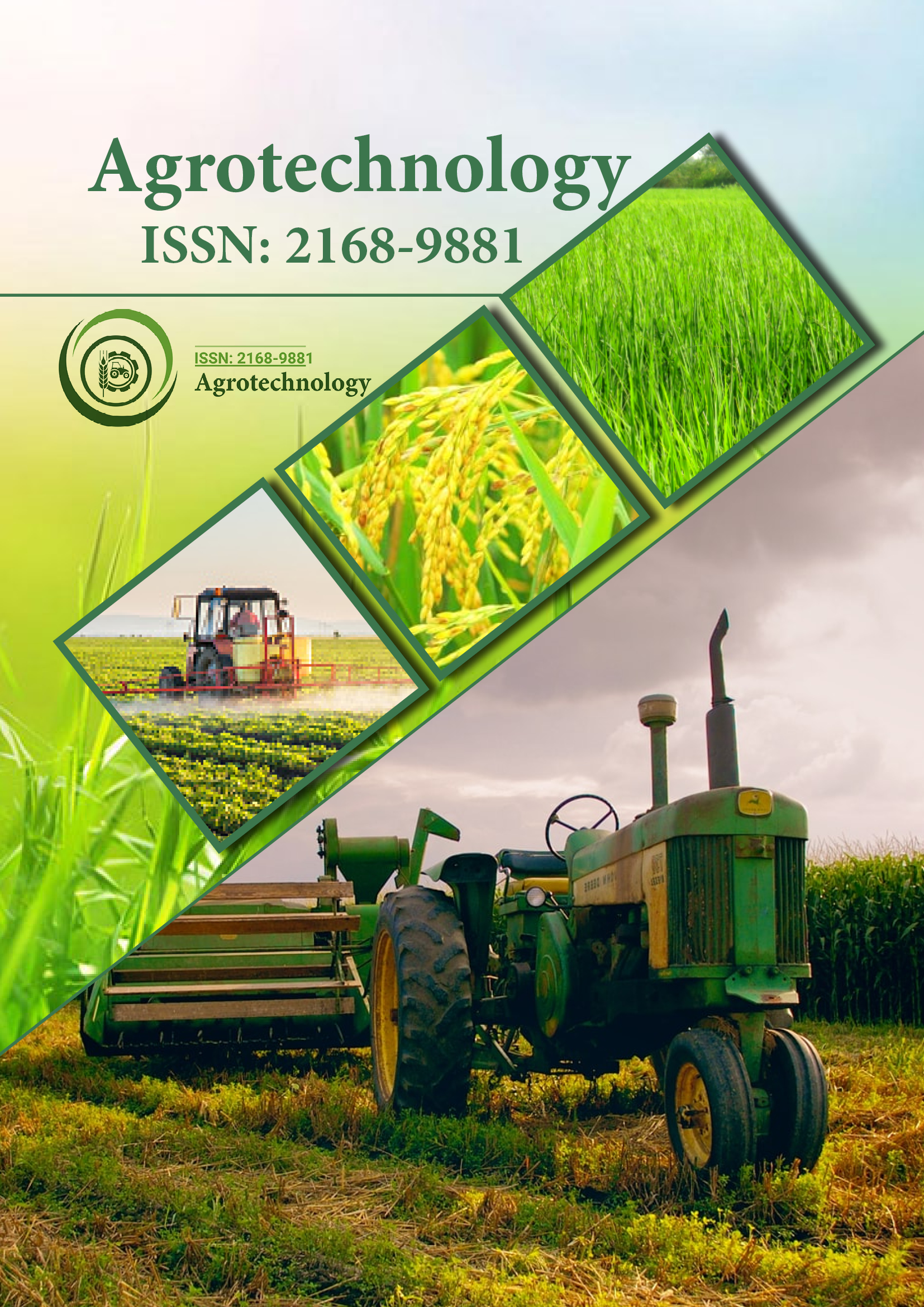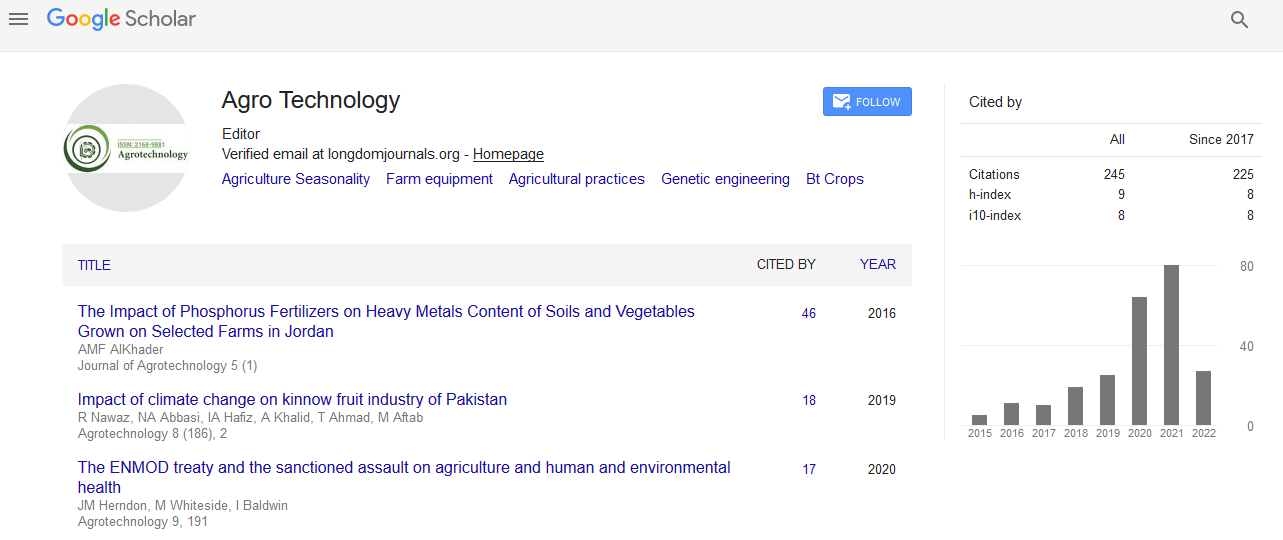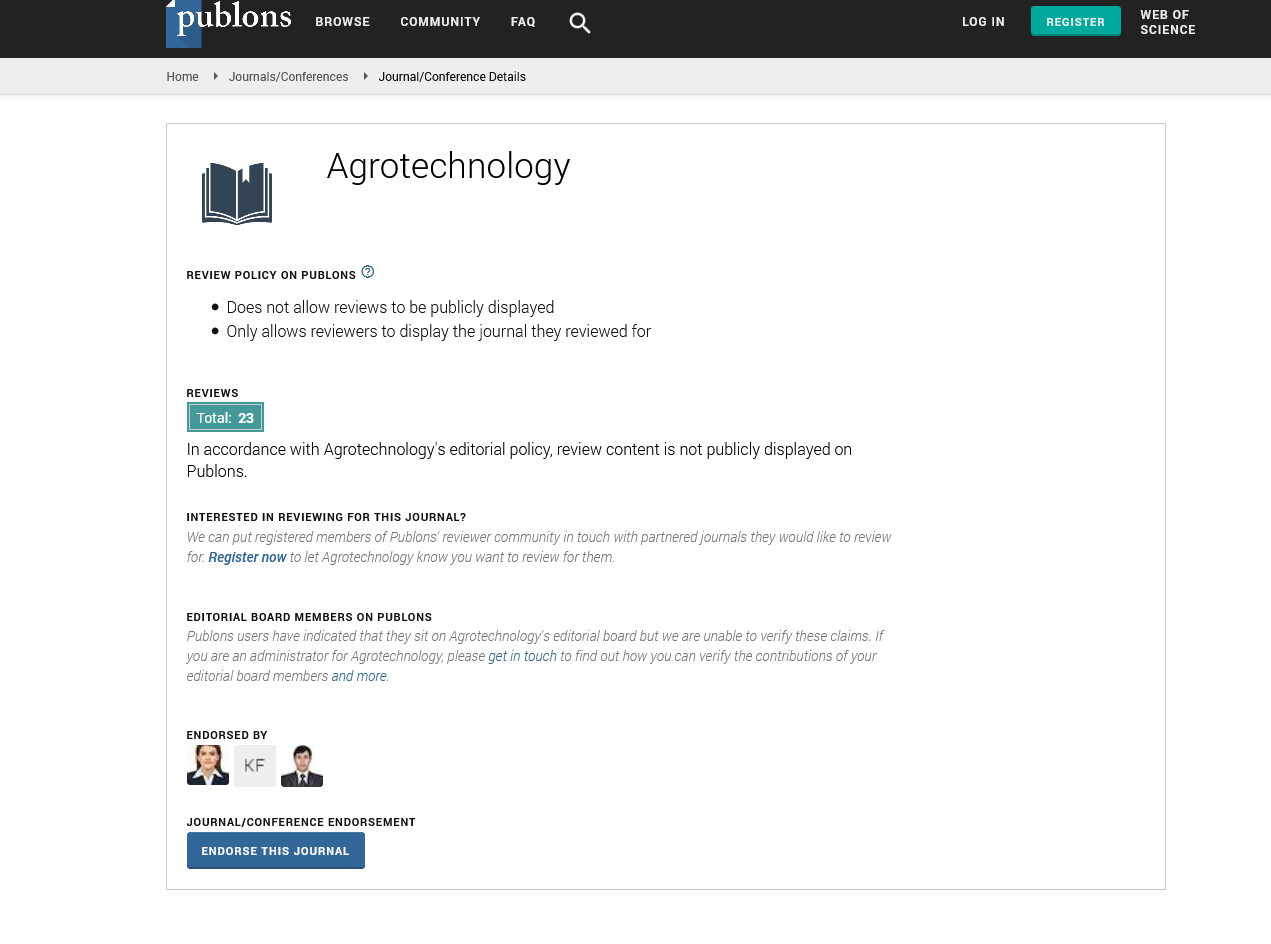Indexed In
- Open J Gate
- Genamics JournalSeek
- Academic Keys
- ResearchBible
- Cosmos IF
- Access to Global Online Research in Agriculture (AGORA)
- Electronic Journals Library
- RefSeek
- Directory of Research Journal Indexing (DRJI)
- Hamdard University
- EBSCO A-Z
- OCLC- WorldCat
- Scholarsteer
- SWB online catalog
- Virtual Library of Biology (vifabio)
- Publons
- Geneva Foundation for Medical Education and Research
- Euro Pub
- Google Scholar
Useful Links
Share This Page
Journal Flyer

Open Access Journals
- Agri and Aquaculture
- Biochemistry
- Bioinformatics & Systems Biology
- Business & Management
- Chemistry
- Clinical Sciences
- Engineering
- Food & Nutrition
- General Science
- Genetics & Molecular Biology
- Immunology & Microbiology
- Medical Sciences
- Neuroscience & Psychology
- Nursing & Health Care
- Pharmaceutical Sciences
Short Communication - (2024) Volume 13, Issue 4
Agricultural Drones: Revolutionizing Soil Monitoring and Crop Management
Li Na*Received: 29-Nov-2024, Manuscript No. AGT-24-27394; Editor assigned: 02-Dec-2024, Pre QC No. AGT-24-27394 (PQ); Reviewed: 16-Dec-2024, QC No. AGT-24-27394; Revised: 23-Dec-2024, Manuscript No. AGT-24-27394 (R); Published: 30-Dec-2024, DOI: 10.35248/2168-9891.24.13.385
Description
Agricultural drones have significantly changed the way soil observation and crop management are done, providing farmers with new applications to increase production and resource efficiency. These drones, which are equipped with advanced sensors, GPS capabilities and high-resolution imagery, give data for exact monitoring of soil health and crop conditions. As the agricultural sector wants organic and affordable methods to increase productivity, drones can help by facilitating resource application, improving crop monitoring and allowing smart decision-making [1].
One of the primary advantages of agricultural drones is the analysis of soil, which is essential to knowing soil variability and improving soil health. Traditional soil testing can be difficult and time-consuming, particularly for large regions. Drones, on the other hand, can immediately collect accurate photographs of a whole field, allowing them to examine changes in soil texture, moisture content and nutrient levels. Farmers can use this information to identify specific regions of the field that require various solutions, such as focused irrigation or specific fertilisation programs. This level of detail enables agricultural practices in which every part of the land receives only the resources it require, ultimately resulting in less waste and better crop performance [2-4].
Drones also provide significant advantages in crop monitoring by offering perspective pictures of fields that indicate changes and challenges that might have detected from the ground [5]. Drones equipped with multispectral cameras may assess plant health by recording variations in colour and light reflection, which may indicate plant stress, illness, or pest infestations. Early detection of these stresses enables farmers to respond quickly and treat challenges before they spread to bigger areas of the crop. For example, areas with nutrient deficiencies can be fertilised more and specific populations of insects can be controlled with concentrated pesticide applications. This accurate monitoring not only saves both resources and time, but it also has a lower environmental impact by reducing the need for a wide range of chemical treatments [6].
In addition, drones facilitate the application of supplies such as fertilizers, insecticides and herbicides. Traditional approaches of applying these components frequently result in mixing and uneven distributions, resulting in inefficient resource consumption and potential negative effects on the environment. Drones complete with precision spraying technology may efficiently make fields, focusing just on the most important areas and applying supplies at the appropriate rate. This specific method is especially beneficial in locations with varying topography, where ground equipment could be challenged. Drones decrease waste and improve crop health by carefully regulating the application process, which immediately contributes to increased yields and a healthier environment [7].
Drones play an essential role in collecting data and planting preparation. Before the planting season, drones can survey and analyse fields to determine topography, soil conditions and other factors that influence planting decisions. This information enables farmers to plan optimal planting types that maximize land utilization while allowing for natural fluctuations in the field. In some cases, drones are utilized to plant seeds directly, especially in places that are difficult to reach or where work is hard. Drones improve the efficiency and adaptability of the planting process, allowing farmers to obtain optimal growth conditions from the initial days of the season [8].
Drones are helping farmers meet environmental challenges through organic farming practices, in addition to providing crop management benefits. Precision irrigation, fertilization and pesticide application reduce the flow and waste, which can contaminate surrounding water resources and impact ecosystems. Drones detect soil erosion, moisture levels and nutrient content, providing data that supports responsible land management and helps in the prevention of soil degradation. These environmentally conscious approaches not only protect surrounding ecosystems, but also improve the sustainable future of agricultural land, providing that farms can continue to provide significant yields from year to year [9].
Drones become increasingly accessible to farms of every type as technological improvements reduce expenses and reduce activities. Whether on an extensive farm or a reduced owned by operation, farmers may now use drone-based monitoring and management technologies to improve their methods. Drone data can be combined with digital farm management systems to monitor crop and soil conditions continuously. Farmers may improve their activities by analyzing trends across several growing seasons, resulting in increased productivity and sustainability. This monitoring ability allows farmers to make choices based on information and respond to changes in soil health or crop performance gradually [10].
A number of the obvious advantages, using drone technology in agriculture require specialized knowledge and regulatory compliance. Effective drone operation requires data analysis skills as well as an extensive knowledge of the regulations controlling drone use in agriculture. However, as drone technology advances and becomes simpler to use, these limitations are gradually separating, making it easier for farmers to include drones in their daily operations.
Conclusion
In conclusion, agricultural drones have changed soil monitoring and crop management, giving farmers solutions that improve precision and efficiency in a variety of farming operations. Drones enhance resource use and increase production potential by allowing for accurate soil analysis, crop health monitoring and controlled nutrient applications. Their advantages reach further productivity, as they stimulate actions that reduce environmental impact and conserve resources. As drone technology advances, its use in agriculture shall grow, helping farmers in completing the demands of modern farming through new solutions that advance both production and sustainability. Agricultural drones, with their Change and adaptability, are setting an example in modern agriculture, allowing farmers to achieve a balance between high production and effective resource management.
References
- Buters TM, Belton D, Cross AT. Multi-sensor UAV tracking of individual seedlings and seedling communities at millimetre accuracy. Drones. 2019;3(4):81.
- Ehrlich PR, Harte J. To feed the world in 2050 will require a global revolution. Proc Natl Acad Sci U S A. 2015;112(48):14743-4.
[Crossref] [Google Scholar] [PubMed]
- Puri V, Nayyar A, Raja L. Agriculture drones: A modern breakthrough in precision agriculture. J Stat Man Sys. 2017;20(4):507-18.
- Vargas-Ramírez N, Paneque-Gálvez J. The global emergence of community drones (2012-2017). Drones. 2019;6:3(4):76.
- Koç C. Design and development of a low-cost UAV for pesticide applications. JAFAG. 2017;34(1):94-103.
- Sinha JP. Aerial robot for smart farming and enhancing farmers' net benefit. Indian J Agric Sci. 2020;90(2):258-67.
- Ferentinos KP. Deep learning models for plant disease detection and diagnosis. Comput Electron Agric. 2018;145:311-8.
- Austin R. Unmanned aircraft systems: UAVS design, development and deployment. John Wiley & Sons; 2011.
- Dutta PK, Mitra S. Application of agricultural drones and IoT to understand food supply chain during post COVID‐19. Agricultural informatics: Automation using the IoT and machine learning. 2021;19:67-87.
- Enciso J, Avila CA, Jung J, Elsayed-Farag S, Chang A, Yeom J, et al. Validation of agronomic UAV and field measurements for tomato varieties. Comput Electron Agric. 2019;158:278-83.
Citation: Na L (2024). Agricultural Drones: Revolutionizing Soil Monitoring and Crop Management. Agrotechnology. 13:385.
Copyright: © 2024 Na L. This is an open access article distributed under the terms of the Creative Commons Attribution License, which permits unrestricted use, distribution, and reproduction in any medium, provided the original author and source are credited.


